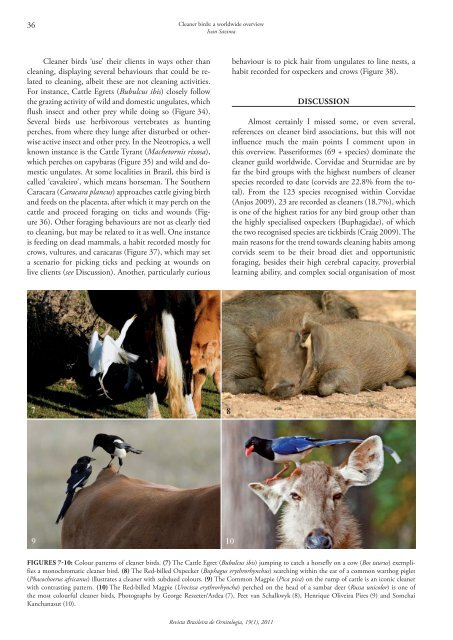Capa 19(1) - fechada.indd - Sociedade Brasileira de Ornitologia
Capa 19(1) - fechada.indd - Sociedade Brasileira de Ornitologia
Capa 19(1) - fechada.indd - Sociedade Brasileira de Ornitologia
You also want an ePaper? Increase the reach of your titles
YUMPU automatically turns print PDFs into web optimized ePapers that Google loves.
36 Cleaner birds: a worldwi<strong>de</strong> overview<br />
Ivan Sazima<br />
Cleaner birds ‘use’ their clients in ways other than<br />
cleaning, displaying several behaviours that could be related<br />
to cleaning, albeit these are not cleaning activities.<br />
For instance, Cattle Egrets (Bubulcus ibis) closely follow<br />
the grazing activity of wild and domestic ungulates, which<br />
flush insect and other prey while doing so (Figure 34).<br />
Several birds use herbivorous vertebrates as hunting<br />
perches, from where they lunge after disturbed or otherwise<br />
active insect and other prey. In the Neotropics, a well<br />
known instance is the Cattle Tyrant (Machetornis rixosa),<br />
which perches on capybaras (Figure 35) and wild and domestic<br />
ungulates. At some localities in Brazil, this bird is<br />
called ‘cavaleiro’, which means horseman. The Southern<br />
Caracara (Caracara plancus) approaches cattle giving birth<br />
and feeds on the placenta, after which it may perch on the<br />
cattle and proceed foraging on ticks and wounds (Figure<br />
36). Other foraging behaviours are not as clearly tied<br />
to cleaning, but may be related to it as well. One instance<br />
is feeding on <strong>de</strong>ad mammals, a habit recor<strong>de</strong>d mostly for<br />
crows, vultures, and caracaras (Figure 37), which may set<br />
a scenario for picking ticks and pecking at wounds on<br />
live clients (see Discussion). Another, particularly curious<br />
behaviour is to pick hair from ungulates to line nests, a<br />
habit recor<strong>de</strong>d for oxpeckers and crows (Figure 38).<br />
Discussion<br />
Almost certainly I missed some, or even several,<br />
references on cleaner bird associations, but this will not<br />
influence much the main points I comment upon in<br />
this overview. Passeriformes (69 + species) dominate the<br />
cleaner guild worldwi<strong>de</strong>. Corvidae and Sturnidae are by<br />
far the bird groups with the highest numbers of cleaner<br />
species recor<strong>de</strong>d to date (corvids are 22.8% from the total).<br />
From the 123 species recognised within Corvidae<br />
(Anjos 2009), 23 are recor<strong>de</strong>d as cleaners (18.7%), which<br />
is one of the highest ratios for any bird group other than<br />
the highly specialised oxpeckers (Buphagidae), of which<br />
the two recognised species are tickbirds (Craig 2009). The<br />
main reasons for the trend towards cleaning habits among<br />
corvids seem to be their broad diet and opportunistic<br />
foraging, besi<strong>de</strong>s their high cerebral capacity, proverbial<br />
learning ability, and complex social organisation of most<br />
Figures 7‐10: Colour patterns of cleaner birds. (7) The Cattle Egret (Bubulcus ibis) jumping to catch a horsefly on a cow (Bos taurus) exemplifies<br />
a monochromatic cleaner bird. (8) The Red-billed Oxpecker (Buphagus erythrorhynchus) searching within the ear of a common warthog piglet<br />
(Phacochoerus africanus) illustrates a cleaner with subdued colours. (9) The Common Magpie (Pica pica) on the rump of cattle is an iconic cleaner<br />
with contrasting pattern. (10) The Red-billed Magpie (Urocissa erythrorhyncha) perched on the head of a sambar <strong>de</strong>er (Russa unicolor) is one of<br />
the most colourful cleaner birds. Photographs by George Reszeter/Ar<strong>de</strong>a (7), Peet van Schalkwyk (8), Henrique Oliveira Pires (9) and Somchai<br />
Kanchanasut (10).<br />
Revista <strong>Brasileira</strong> <strong>de</strong> <strong>Ornitologia</strong>, <strong>19</strong>(1), 2011

















